Mastering Dutch Oven Cooking: A Comprehensive Guide
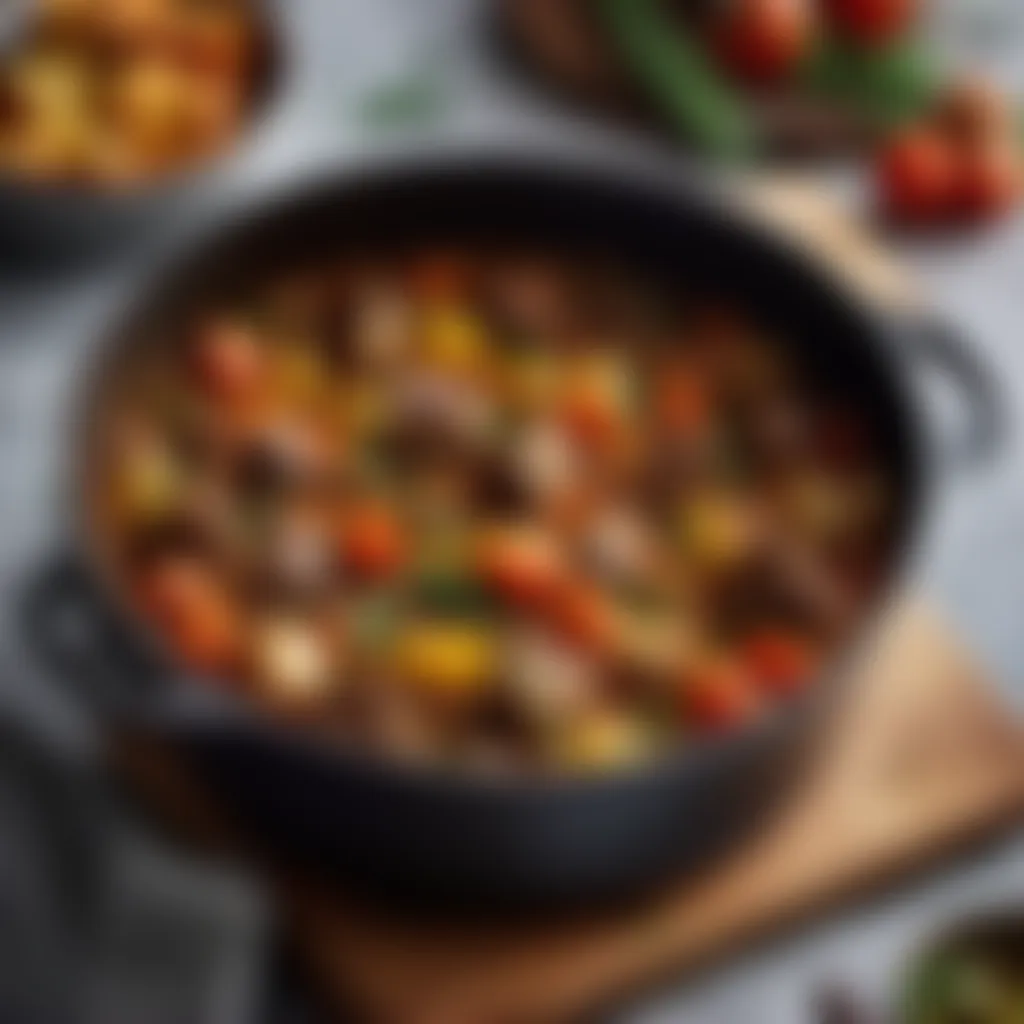

Intro
Cooking with a Dutch oven is more than just a culinary technique; it’s a tradition steeped in history and creativity. For many home cooks, this versatile pot serves as a trusty companion, whether it's used for slow-cooking a hearty stew or baking a rustic loaf of bread. A Dutch oven can transform ordinary ingredients into culinary masterpieces, making it a must-have in every kitchen.
Familiarity with the Dutch oven can unlock a treasure trove of possibilities. At its core, this cooking vessel utilises even heat distribution, allowing for exquisite flavor development and texture control. As you dive into this guide, you’ll find essential tips and recipes that merge history with practical use to make your dishes sing.
Let's begin our flavorful kitchen journey by exploring the ingredients crucial for your Dutch oven recipes.
Prolusion to Dutch Ovens
Dutch ovens are like the Swiss Army knives of the kitchen. These versatile pots can braise, bake, stew, and even fry, making them indispensable for any home cook looking to streamline their meal prep. The beauty lies not just in their functionality, but also in how they foster a sense of community and comfort during cooking. Imagine gathering around a pot of bubbling stew on a chilly evening or baking fresh bread that fills the air with a warm, inviting aroma. There's something truly special about this cooking method that goes beyond simply preparing food.
Moreover, learning about Dutch ovens equips you with a deeper understanding of how these pots work. You’ll discover their unique designs, which can significantly affect cooking times and flavors. It’s essential for anyone in the kitchen to grasp the capabilities of their tools – effective cooking starts with choosing the right equipment.
Additionally, this guide aims to highlight the immense benefits of utilizing Dutch ovens, such as even heat distribution and the ability to go from stovetop to oven seamlessly. Knowledge of these advantages can truly elevate your culinary experience.
"A well-used Dutch oven tells a story through the meals prepared and shared over the years."
In the sections that follow, you’ll gain insight not only about the elements that make Dutch ovens special but also how to care for them, ensuring they remain a staple in your kitchen for years to come.
The Essence of Dutch Ovens
Dutch ovens have a rich, textured character. They’re made to withstand intense heat and provide superb heat retention, allowing you to cook meals evenly. When you think of a Dutch oven, envision a sturdy, heavy pot with a lid that fits snugly; this is where the magic happens. The lid locks in moisture, creating a mini-oven effect that can transform tough cuts of meat into tender, flavorful dishes.
Also, the aesthetics can range from rustic to modern, often adding a touch of elegance to your dining table. Their resilience means they can travel from the oven to the table and then to the fridge for leftovers without missing a beat. Periodic seasoning not only maintains their non-stick surface but also enhances the rich colors of the cast iron, making them a joy to use and display.
A Brief Historical Overview
The origins of Dutch ovens are steeped in history. These pots date back to the 18th century, with their roots believed to be in the Netherlands, where they were crafted from clay. The term "Dutch oven" is said to stem from the casting method utilized in the region, particularly in a town called "Delft."
In the 19th century, cast iron became the go-to material for these pots, favored for its durability and heat retention properties. Manufacturing innovations led to the widespread popularity of cast iron Dutch ovens, allowing cooks to harness their unique capabilities at home.
These pots were even taken on the Oregon Trail by pioneers who appreciated their ability to cook large meals over an open fire. Fast forward to today, Dutch ovens still hold a valued place in modern kitchens around the globe, bringing with them a sense of tradition and nurturing with every meal prepared.
Understanding Your Dutch Oven
Understanding your Dutch oven is important because it’s like knowing the shoes you’re wearing. You wouldn’t run a marathon in flip-flops, right? So, having a solid grasp of how these magical pots work can make the difference between a culinary triumph and a total flop. Here, we’re digging into the materials and construction that make up these beloved kitchen partners, as well as how to thoughtfully choose the right size for your needs.
Materials and Construction
When it comes to Dutch ovens, the materials they’re made of tell a big chunk of the story. Different materials bring to the table both unique benefits and challenges. Let’s break them down.
Cast Iron
Cast iron is the heavyweight champion of Dutch ovens. First off, it’s known for its remarkable heat retention, which allows for even cooking. This means your beef stew won’t have cold patches, and that’s something we can all toast to! Cast iron can go from stovetop to oven without skipping a beat, making it a versatile player in any cooking scenario.
However, there are a few things to keep in mind. While they may be bulletproof in durability, cast iron Dutch ovens are often heavy. This can be a bit of a workout when you’re lifting a pot filled with ingredients. Moreover, they require a little TLC when it comes to seasoning to maintain that non-stick surface and ward off rust. So, if you're ready for a bit of a commitment, cast iron is where it’s at.
Enamel Coating
Now, let’s chat about enamel-coated Dutch ovens. These beauties shine in both aesthetics and function. The enamel coating provides a non-reactive surface, which means they won’t tarnish the flavor of acidic foods like tomato sauce. Plus, clean-up is a breeze. You can toss them in the dishwasher, but a simple wash with soap and water usually does the trick just fine.
On the downside, while the enamel is quite sturdy, it can chip if you’re not careful, especially against hard surfaces. This can lead to rusting, which is a no-go for long-term use. Still, their vibrant colors and ability to serve beautifully at the dinner table earn them a special place in many kitchens.
Other Materials
Finally, we have to acknowledge that not all Dutch ovens are made of the traditional materials. Some have a core made of aluminum or even ceramic. These materials can be helpful in reducing weight—great for those who might struggle with the heft of cast iron! Aluminum may heat up quickly, but it doesn’t retain heat as well as cast iron, which could affect slow-cooking methods.
Ceramic options can be charming too, providing a nice look for serving at the table. However, it might not have the same capacity for high heat as cast iron or enamel-coated pots, limiting your cooking capabilities. Understanding these materials reflexes on your choice and gets you closer to unlocking the real potential of your Dutch oven experience.
Choosing the Right Size
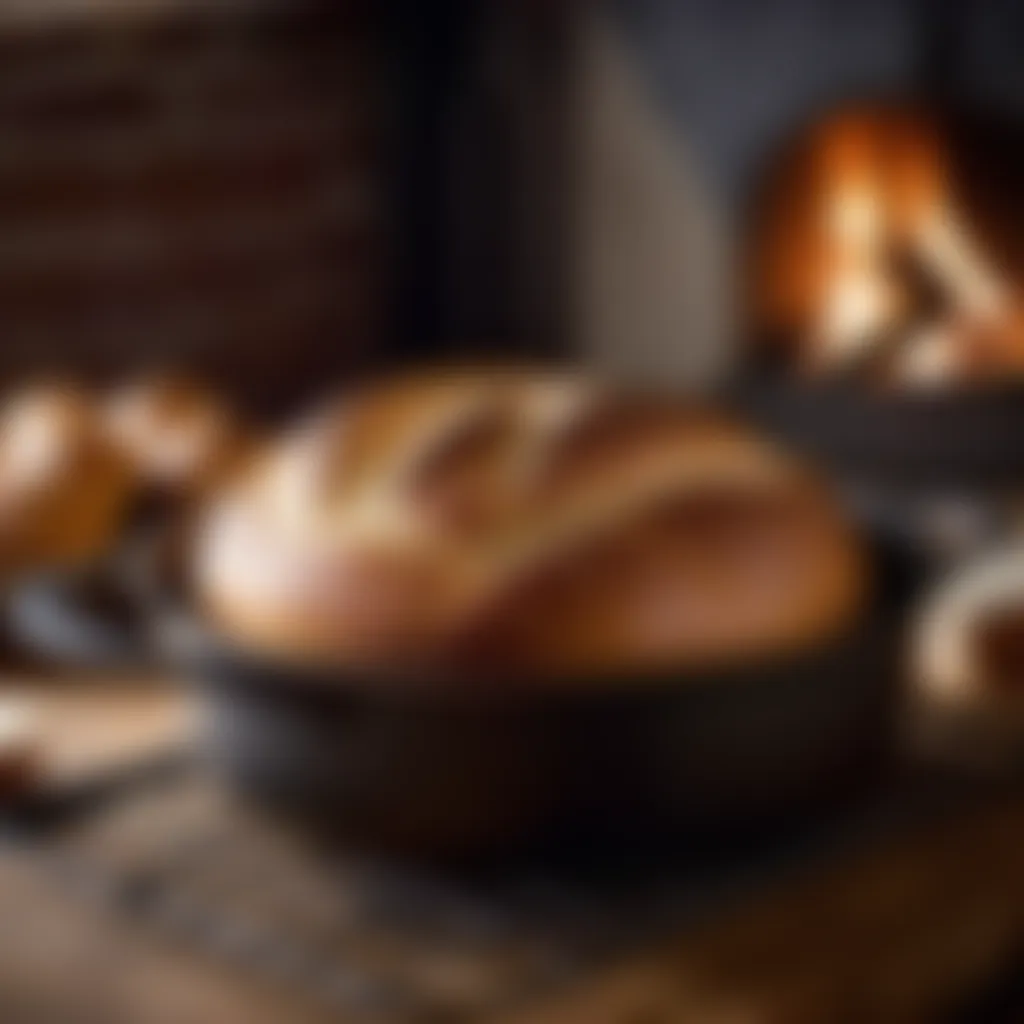

The size of your Dutch oven can make or break your recipe. Think of it as a wardrobe fit—too small and you’re uncomfortable, too big and you might look lost in fabric. Sizes typically range from a petite 2-quart all the way up to a grand 8-quart. So how do you know what to get? Here are a few pointers:
- Consider Your Household Size: For a family of four, a 5 or 6-quart oven strikes a balance between capacity and ease of handling.
- Dish Type: If you're planning on whipping up a big batch of chili for a gathering, lean towards the larger sizes. For a cozy stew, you might not need more than 4 quarts.
- Cooking Style: The style of cooking also plays a part. If you enjoy slow-cooked meals or large portions, a bigger pot is more favorable. For smaller side dishes or baking bread, a smaller size will suffice.
In the end, your selection should align with what fits your culinary needs while ensuring that each meal comes out just right!
Techniques for Cooking with a Dutch Oven
Cooking with a Dutch oven can seem a bit intimidating at first, but mastering the techniques is key to unlocking the full potential of this versatile cookware. These techniques not only enhance the flavors of your dishes but also allow for a variety of cooking styles, making it easier to whip up everything from hearty meals to delicate baked goods. Considering cooking with a Dutch oven, it's essential to understand its unique capabilities—think moisture retention, even heating, and how it can go from stovetop to oven without a hitch. With these techniques, you'll find cooking becomes a joyful experience rather than a chore, all while impressing family and friends.
Preheating and Searing
Preheating your Dutch oven is a game changer. By bringing it up to the right temperature before adding any ingredients, you prepare your base for a depth of flavor that only comes from good searing. Take that roast, for example, and imagine dropping it into a cold pot versus a hot one—totally different results. When the pot is preheated, you get a beautiful brown crust, which not only looks appetizing but also seals in the juices, keeping your meat tender.
While it's tempting to throw everything in at once, patience comes into play while preheating. Whether you’re making a rustic stew or searing steak, letting your Dutch oven reach the desired temperature can be the difference between delicious and disappointing.
Braising and Stewing
Braising and stewing are two cornerstone techniques for creating soul-warming meals. Both methods rely on slow cooking, allowing flavors to meld beautifully. The Dutch oven’s design excels at this, with its heavy lid trapping steam, which bodes well for flavor infusion.
Let’s break it down: braising involves first searing your meat and then adding in your liquid before covering and cooking low and slow. Stewing, on the other hand, might involve immersing bite-sized pieces of meat directly in a flavorful broth. Both approaches create suppers that soothe the soul and bring warmth to your kitchen.
Baking in a Dutch Oven
Baking in a Dutch oven turns out to be a delightful surprise for many. Who knew this robust pot could churn out fresh bread or comforting casseroles?
Breads and Rolls
Baking bread in a Dutch oven creates a crust that’s hard to beat. The pot simulates a steam oven, which is crucial for achieving that crusty exterior and fluffy interior we all crave. One of the best aspects of baking bread is how straightforward it is. Mix your ingredients, let the dough rise, and place it inside that preheated Dutch oven. Simple as pie! But, do take care to use parchment paper for easier transfer.
The key characteristic of Dutch oven bread is its crisp crust and tender crumb. For novice bakers, the guidance of this pot leads to success nearly every time, making it a popular choice for home bakers.
Casseroles
Casseroles allow for creativity in the kitchen, and a Dutch oven simplifies the process. With its generous size, you can layer ingredients without worrying about spills. Simply throw everything into your pot and let the flavor meld over low heat. A standout feature of using a Dutch oven for casseroles is how it retains heat, evenly cooking everything and resulting in a dish that looks and tastes luxurious.
However, be mindful—while these meals are forgiving, overcooking can turn your lovely casserole into an unappetizing mush. Keep an eye on it, and you'll enjoy comfort food at its finest.
Cakes and Puddings
Yes, you can bake cakes and puddings right in your Dutch oven! The unique shape and heavy lid make it ideal for producing moist cakes. Think of it like a steaming method—one that brings super moist textures to your favorite recipes.
The notable aspect here is how versatile this cookware can be. You can make everything from sponge cakes to rich, decadent puddings with relative ease. But don't forget to check for doneness a bit earlier than you might in a traditional oven, as cooking times may vary slightly.
In summary, embracing these techniques elevates your cooking game significantly. Each method—preheating, braising, baking—unleashes flavors and textures you wouldn’t achieve otherwise. Get your hands dirty and explore the endless possibilities of your Dutch oven!
Essential Dutch Oven Recipes
In the realm of Dutch oven cooking, the recipes you choose can mark the difference between a mundane meal and an extraordinary culinary experience. Each recipe harnesses the unique cooking abilities of the Dutch oven, transforming basic ingredients into hearty and flavorful dishes. This section delves into a selection of essential recipes that take full advantage of the Dutch oven's capabilities, showcasing its versatility and ability to create satisfying comfort food.
Hearty Soups and Stews
Hearty soups and stews represent the epitome of Dutch oven cooking. They embody warmth and nourishment, perfect for gatherings or a quiet evening at home. The slow cooking process allows flavors to marry beautifully, resulting in dishes that not only smell divine but also bring joy and satisfaction to the table.
Classic Beef Stew
Classic Beef Stew is a mainstay in many households, and for good reason. This dish harmonizes tender beef with vegetables, herbs, and a rich, savory broth. The key characteristic of this stew is its depth of flavor, built through browning the beef and simmering the ingredients over time. It ends up being a crowd-pleaser, making it a beneficial choice for family dinners or when entertaining guests.
One unique feature of Classic Beef Stew is its adaptability. You can throw in seasonal veggies or add more spices based on your preferences, which enhances its overall appeal. However, one disadvantage may arise from the time commitment; it often requires a few hours of simmering to achieve that melt-in-your-mouth texture.
Chili con Carne
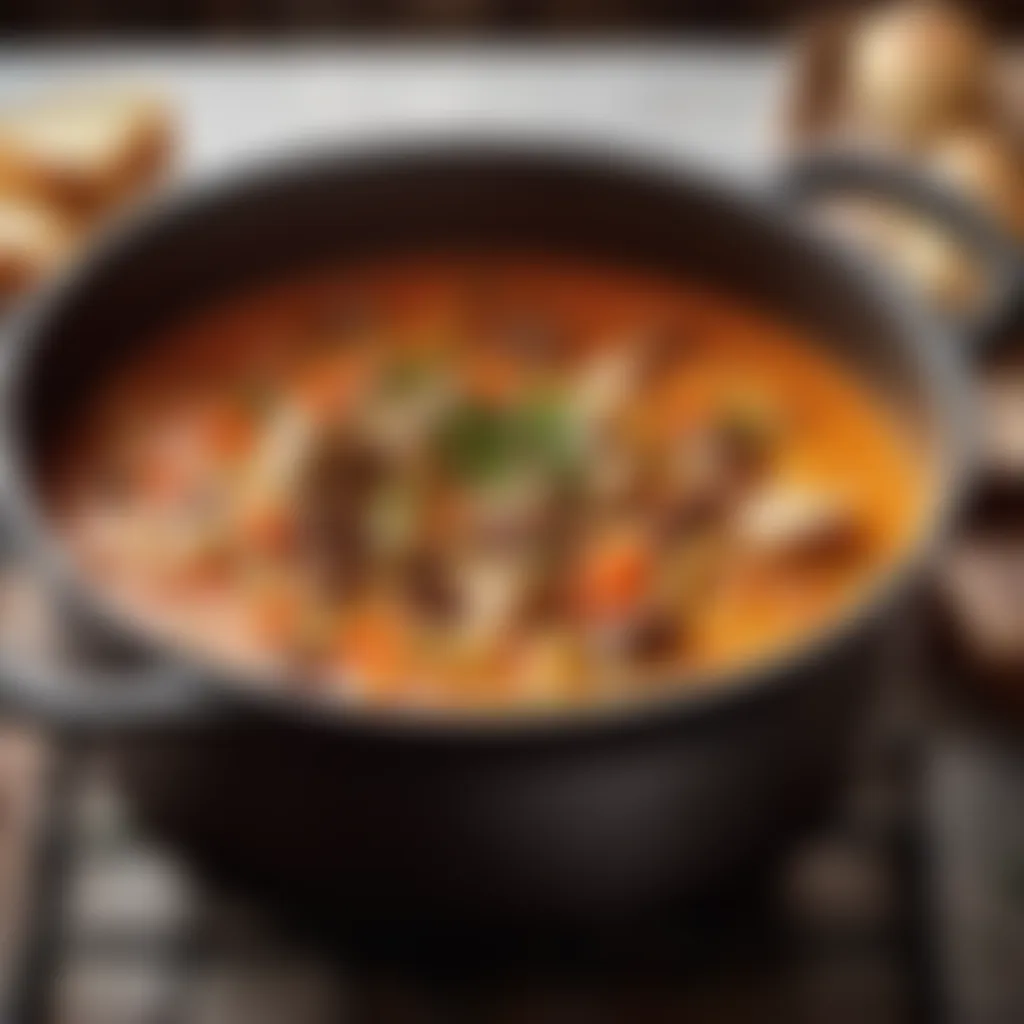

Chili con Carne is another phenomenal option, bursting with robust flavors. This dish typically combines ground beef, beans, tomatoes, and a symphony of spices to create a warming bowl that comforts the soul. What makes this dish stand out is its versatility: whether you like it mild or spicy, you can easily adjust the heat level to suit everyone’s taste.
The unique feature of Chili con Carne lies in its ability to serve a crowd with relatively minimal effort. It cooks well in bulk, and leftovers often taste even better the next day. On the downside, if you are not careful, it can turn out too salty or spicy, but with a few taste tests, you can get it just right.
Vegetable Minestrone
For those looking for a lighter option, Vegetable Minestrone is a fantastic choice. It's loaded with seasonal vegetables, beans, and pasta, all simmered in a flavorful broth. The key characteristic of Minestrone is its flexibility; you can include whatever vegetables are on hand, making it a great option for using up what might otherwise go to waste.
What sets Vegetable Minestrone apart is its bright and fresh flavors while being hearty enough to satisfy. Plus, it is generally quite healthy, making this a beneficial addition to your Dutch oven repertoire. One downside might be that it can get a bit watery if not enough ingredients are added, so it's crucial to be mindful of ingredient proportions.
Savory One-Pot Meals
Savory one-pot meals are the ultimate convenience food. They require minimal cleanup and allow for a delightful melding of flavors. Cooking these dishes in a Dutch oven emphasizes the simplicity and effectiveness of one-pot cooking.
Coq au Vin
Coq au Vin is a classic French dish that combines chicken with wine, mushrooms, and herbs. The beauty of this meal is how the rich flavors develop as it cooks slowly in the Dutch oven. Its key characteristic is the deep, aromatic quality that emerges from the tender chicken steeped in wine.
One noteworthy aspect of Coq au Vin is the opportunity for creativity; you can experiment with different wines or add bacon for an extra layer of richness. However, it does require a good quality wine, which might make it less accessible for those on a budget.
Risotto
Risotto is celebrated for its creamy texture and comforting nature. Cooking it in a Dutch oven allows for an even heat distribution that aids the slow stirring process necessary to achieve that perfect texture. A distinctive characteristic of Risotto is its adaptability, as it can incorporate a wide range of flavors from herbs to vegetables.
However, the time-consuming nature of stirring can be a hindrance for some. The risk of overcooking or undercooking the rice is present, but with practice, one can master the technique fairly easily.
Baked Ziti
Baked Ziti is the kind of dish that symbolizes joy and togetherness, likely to bring smiles at the dinner table. Its key feature is the gooey cheese and rich tomato sauce melding beautifully together. This dish is hugely beneficial since it can be prepared ahead of time and reheated when needed, perfect for busy nights.
One downside, though, is that it can be calorie-laden due to the cheese, which may deter those watching their diets. Still, the satisfaction it delivers makes it worth considering.
Breads and Baking Delights
Other delicious options that the Dutch oven can facilitate include breads and various baked items that are simply hard to resist. This method allows for even baking and extraordinary crusts, turning out loaves that make the effort truly worthwhile.
Decadent Desserts
Desserts cooked in a Dutch oven can take your sweet offerings to a whole new level, offering unique textures and a warm, inviting presentation. One gets to enjoy delightful options that provide comfort while being notably satisfying. Let's explore a few standout dessert recipes.
Apple Crisp
Apple Crisp showcases the beauty of seasonal fruits beautifully complemented by a crunchy oat topping. Its key characteristic is that contrasting texture—soft, warm apples paired with a crispy topping. This makes it a popular choice for fall gatherings.
A standout feature of Apple Crisp is its simplicity; with just a few ingredients, you can whip up a comforting dessert in no time. However, it can sometimes turn out too watery if the apples are overly juicy, which can dampen the overall experience.
Chocolate Lava Cake
Chocolate Lava Cake takes indulgence up a notch, tantalizing dessert lovers everywhere with its gooey center. The defining feature of this dessert is its rich chocolate flavor that lingers on your palate, making it a favorite for special occasions.
One advantage of making this in a Dutch oven is the effective heat control that results in consistent cooking. Yet, the downside can be tricky; undercooking or overcooking can easily ruin that molten center!
Peach Cobbler
Peach Cobbler shines in the summer, bursting with sweet, aromatic peaches underneath a biscuit-like topping. The key characteristic of this cobbler is the fusion of soft peaches and tender dough, evoking memories of summer barbecues.
Its unique feature is its ability to be customized with other fruits, providing a burst of flavor and nostalgia. However, it’s essential not to overbake; otherwise, the topping can become too dry.
With these recipes, your Dutch oven can become a cornerstone in your kitchen. Its ability to create nourishing meals, sweet treats, and everything in between makes it a worthy investment for anyone intent on exploring the culinary arts.
"A Dutch oven is not just a cooking tool; it's a gateway to creating memorable experiences around the dinner table."
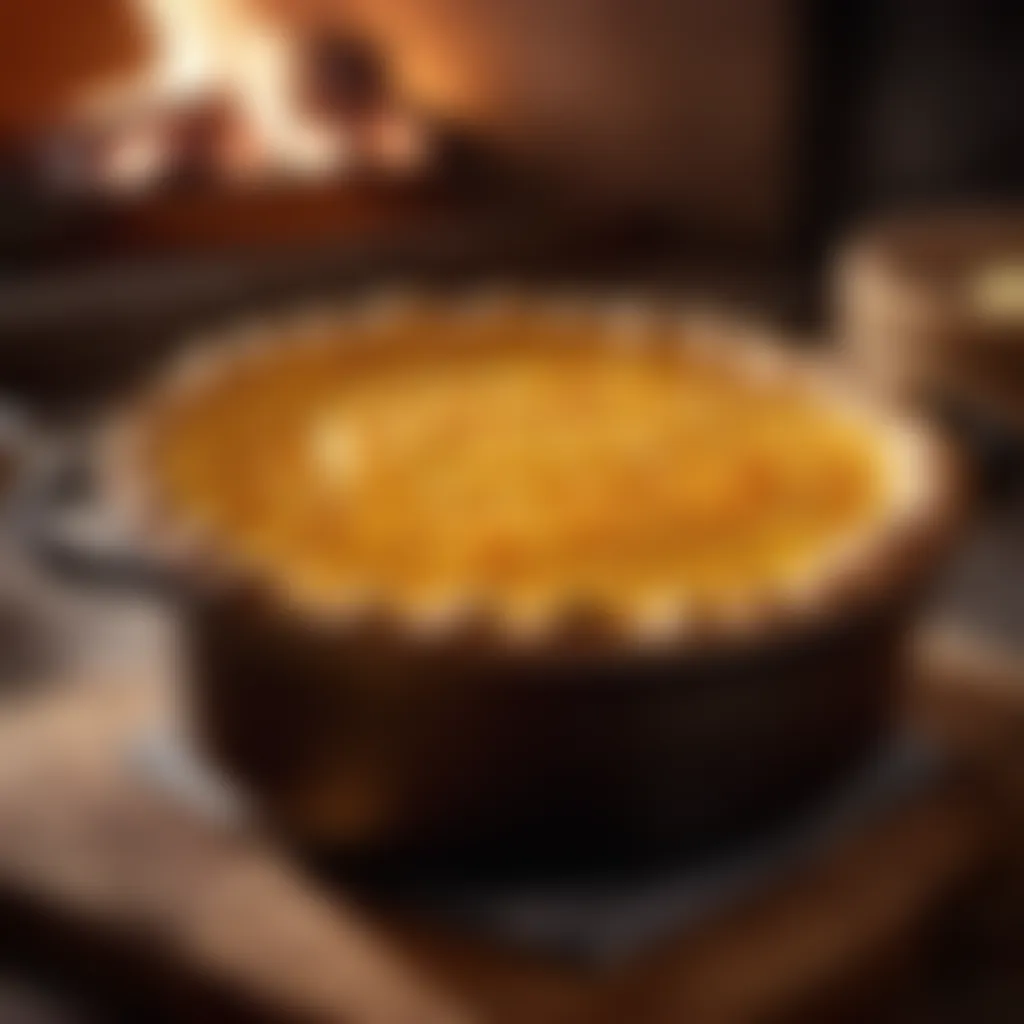
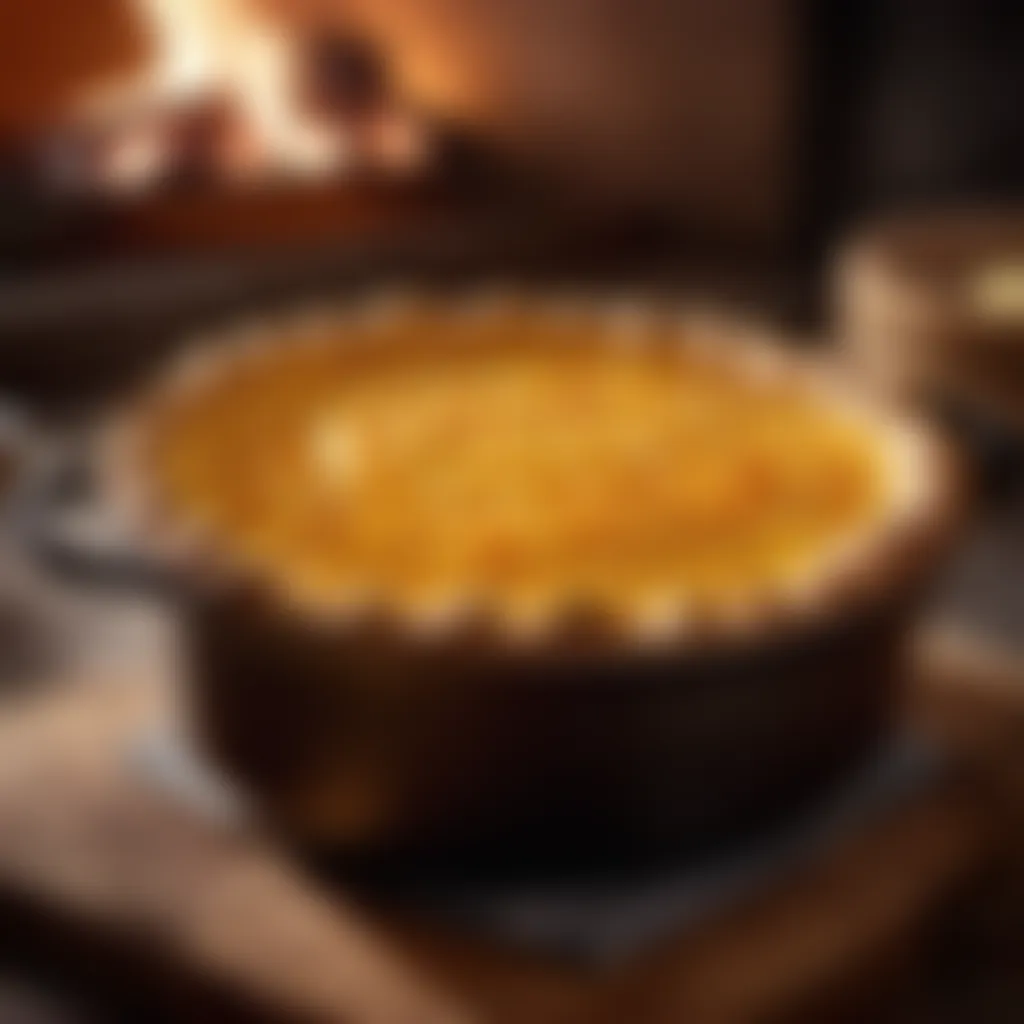
As you progress through these essential recipes, remember that the key to success lies in understanding the unique properties of your Dutch oven and allowing your personal touch to shine through!
Caring for Your Dutch Oven
Caring for your Dutch oven is paramount for achieving longevity and maintaining its efficiency in cooking. Whether you inherited a vintage piece or purchased a brand-new model, your approach to its upkeep can substantially impact its performance over the years. The beauty of a Dutch oven lies not just in its versatility for cooking a plethora of dishes but also in how it can age like fine wine when handled with care. Regular maintenance and proper cleaning techniques not only preserve its look but also ensure that each meal prepared in it brings a delight to the taste buds.
Cleaning Techniques
Cleaning a Dutch oven may seem daunting at first, especially if you’ve cooked rich, hearty meals in it. However, there are effective methods to keep it in tip-top shape without breaking a sweat. Here are some practices you might find helpful:
- Let it Cool: Patience is a virtue. Allow your oven to cool before cleaning to prevent thermal shock that can crack the enamel.
- Scrape the Residue: Use a spatula or wooden spoon to gently scrape off any stuck-on food. Avoid metal utensils as they can scratch the surface.
- Soak, Don’t Scrub: If there are stubborn stains, fill the pot with warm soapy water and let it soak for a while instead of scrubbing hard. This method helps to lift away grime without damaging the enamel.
- Rinse and Dry: After soaking, rinse thoroughly and dry. Leaving it damp can lead to rust, especially with cast iron pieces. For cast iron, it’s also wise to wipe it with a bit of oil before storing.
"A well-cared-for Dutch oven may just become a family heirloom, passed down from generation to generation."
Seasoning for Longevity
If your Dutch oven is made of cast iron, seasoning is crucial for its longevity and non-stick capabilities. This process involves applying a thin layer of oil to the surface, creating a barrier that not only protects the metal from rust but also enhances the natural flavor of the food prepared in it. Here’s how you can go about seasoning your Dutch oven:
- Choose the Right Oil: Opt for an oil with a high smoke point, such as flaxseed or grapeseed oil. Avoid butter or olive oil as they can leave residues that can become sticky.
- Clean the Surface: Start with a clean surface. If it’s your first time seasoning or the pot is particularly grimy, consider washing it with soap to remove any old food particles.
- Apply Oil Sparingly: Pour a small amount of oil onto a cloth and spread it evenly over the inner and outer surfaces.
- Heat the Oven: Place the Dutch oven inverted in the oven at a medium heat (around 350°F) for about an hour. This allows the oil to bond with the cast iron.
- Let it Cool: After baking, turn off the oven and let the Dutch oven cool inside to prevent cracking.
Incorporating these care tips into your regular cooking routine not only preserves the integrity of your Dutch oven but also elevates your culinary experience. Taking a few minutes to properly clean and season your cookware can make a world of difference, ensuring that it delivers excellent results meal after meal.
Tips for Cooking Success
When it comes to mastering the Dutch oven, the road ahead is paved with knowledge and a sprinkle of finesse. Tips for Cooking Success will arm you with strategies to elevate your culinary prowess and maximize the potential of this beloved kitchen tool. Understanding the nuances of ingredients and common pitfalls can turn a good meal into a great one.
Ingredients That Work Best
Using the right ingredients can make all the difference in achieving that sumptuous flavor profile we all crave. Given the firm and even heat distribution of a Dutch oven, it's essential to select high-quality components. Here are some favorites:
- Meats: Opt for tougher cuts like chuck roast or pork shoulder. These cuts shine in long-cooking situations, becoming tender and flavorful.
- Vegetables: Root vegetables like carrots, parsnips, and potatoes do exceptionally well. They release their natural sweetness and absorb the braising liquid like a sponge.
- Herbs and Spices: Fresh herbs like thyme and rosemary bring a bright note to your dishes. They can withstand longer cooking times without losing their essence. Dry spices are also beneficial, provided they are fresh; stale spices lose their punch quickly.
- Liquids: Stocks, broths, and even wine can add depth to flavors. Avoid using too much liquid, as the Dutch oven's heavy lid locks in moisture, often making a little go a long way.
Choosing quality ingredients isn’t just about health; it’s about taste. When you combine good produce with proper technique, you're setting yourself up for success from the start.
Avoiding Common Mistakes
No one is perfect, and even the most seasoned cooks can have a misstep or two. However, understanding common blunders can help you sidestep the traps many fall into:
- Overcrowding the Pot: It might be tempting to load the Dutch oven to the brim, but leaving space allows food to brown properly and ensures even cooking. Think of it as giving each ingredient room to shine.
- Not Preheating: Forgetting to heat up the pot before adding ingredients can lead to a soggy start. Preheating helps achieve the brown crust on meats – a delicious way to kick off a recipe.
- Ignoring Recipe Timings: Dutch ovens work their magic over time. Rushing the cook can lead to tough meat and undercooked veggies. Patience is key; allow the heat to work its wonders slowly.
- Failure to Season: Don't skimp on seasoning! A well-seasoned dish is almost always more flavorful. Season at different stages to build depth, rather than just at the end.
A little bit of salt at the start and adjustments at the end create a layered taste unlike any other.
- Improper Cleaning and Care: Last but not least, maintaining your Dutch oven is crucial. Neglecting its care can lead to rust or stuck-on bits that make cooking a hassle.
In sum, honing these skills helps avoid pitfalls and enhances the richness of your meals. Paying attention to these tips, you not only improve your dishes but also enjoy the cooking process even more. With each recipe, you’re one step closer to culinary mastery.
Finale
The conclusion of our guide brings it all together, emphasizing the multifaceted role a Dutch oven plays in the kitchen. A Dutch oven isn't merely a pot; it's a lifetime companion that brings comfort to meals, transforms ingredients, and elevates culinary experiences.
One cannot overlook the versatility of a Dutch oven. From simmering a hearty beef stew on a chilly night to baking artisan breads, its ability to perform numerous cooking techniques is unmatched. This adaptability is an essential consideration for housewives looking to simplify meal preparation without compromising on flavor or nutrition.
Moreover, with the right care and maintenance, a Dutch oven can last for generations. This longevity aligns perfectly with the growing trend towards sustainable cooking, promoting the use of durable kitchen tools rather than disposable alternatives. By investing in a high-quality pot, not only do you save money over time, but you also contribute to a greener lifestyle.
It’s also important to acknowledge the sense of community that often forms around the culinary arts. When you cook with a Dutch oven, you’re putting together not just a meal, but a memory. Gatherings centered around a sizzling pot of Coq au Vin or a bubbling Peach Cobbler foster connections, bringing family and friends together to share in the joy of good food.
In summary, the advantages of using a Dutch oven are numerous, spanning practicality, efficiency, and emotional satisfaction. As you embark on your cooking journey with this invaluable tool, remember that each recipe is not just about the ingredients, but about the traditions, love, and care infused into your dishes. So, embrace the magic of your Dutch oven and let it inspire unforgettable meals, cherished connections, and a lifetime of culinary adventures.
"A pot like this holds not just food, but memories that simmer with time."
The Dutch Oven Advantage
When we talk about the Dutch oven advantage, we refer to the unique characteristics that set this kitchen tool apart from others. The heavy construction and tight-fitting lid are significant because they ensure even heat distribution and moisture retention. These qualities are particularly beneficial when braising meats or baking bread, resulting in dishes that are tender, flavorful, and rich in character.
Here are just a few key benefits of using a Dutch oven:
- Versatile Cooking: You can use it on the stovetop, in the oven, or even over an open flame. From soups to casseroles to bread, there's no limit.
- Energy Efficient: The thick walls retain heat, allowing you to use lower temperatures and less energy without sacrificing cooking quality.
- Flavor Enhancement: Its ability to trap steam and flavors leads to meals that often taste better on day two, perfect for make-ahead dishes.
- Durable Investment: A well-maintained Dutch oven can last a lifetime, making it a cost-effective choice for home cooks.







